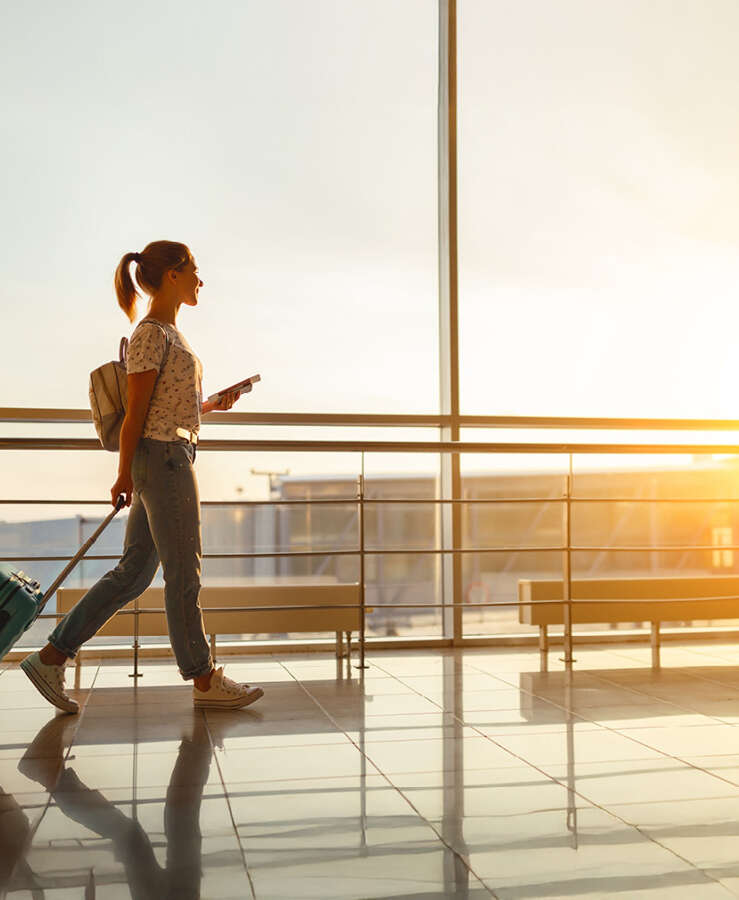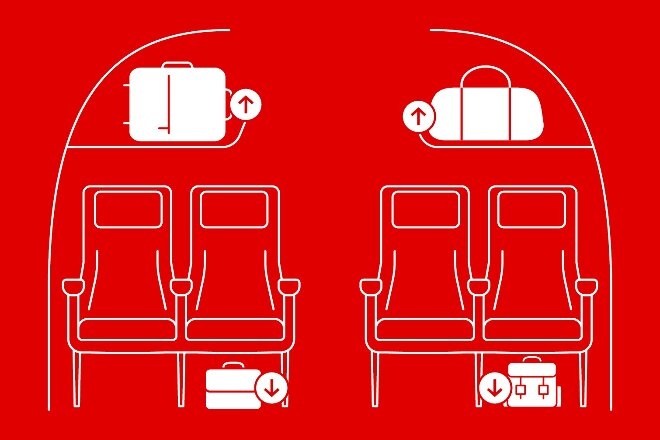
Carry-on baggage
Find out about the size, weight and number of bags you can take onboard, whether you’re travelling domestically within Australia or internationally.
Your guide to carry-on baggage
Ensure your carry-on baggage fits within the allowance These limits are to ensure your safety, and the safety of our crew.
Check your bags adhere to the Dangerous goods and Airport Security Screening regulations e.g. liquids, aerosols, gels.
Check you can lift your own bag. If it is too heavy for you to lift into the overhead lockers, it will need to be checked in. This includes musical instruments and strollers

1 Up, 1 Down
When travelling during peak times, storage for carry-on baggage may be limited. With checked baggage included in every fare, it’s best to check in bags that aren't required inflight.
Once onboard, help us take off on time by placing your larger bag up in the overhead locker, and your smaller bag or personal item under the seat in front.
This is a guide where limits and space allow. When travelling on our Dash 8 aircraft, your small wheelie bags will be collected at boarding and returned upon arrival.
Carry-on allowances
Find out the specific size, weight and number of bags you can take onboard Qantas and QantasLink operated flights, Jetstar or partner flights.
Carry-on baggage will be monitored at the airport and bags that exceed the limits won't be permitted in the aircraft cabin. If your carry-on baggage exceeds the allowances, we recommend checking it in.
If you have booked both a domestic and international Qantas flight as part of your travel, please pack your carry-on to follow the international guidelines (except Dash 8 services as these services have their own allowances).
Domestic flights (except Dash 8 services)
The following allowances apply to all flyers (except infants), including all Qantas Frequent Flyer members travelling in all cabins.
Choose from one of these options:

One standard piece
For example, a small wheelie bag.
- 10kg (22lb) total
- Bag size: 56cm (22in) long x 36cm (14in) wide x 23cm (9in) deep

Two small pieces
For example, two smaller duffle-style bags or backpacks.
- 14kg (30lb) total (each piece must not exceed 10kg (22lb))
- Bag size: 48cm (18in) long x 34cm (13in) wide x 23cm (9in) deep

One small piece and garment bag
For example, a small duffle-style bag or backpack, and a garment bag.
- 14kg (30lb) total (each piece must not exceed 10kg (22lb))
- Bag size: 48cm (18in) long x 34cm (13in) wide x 23cm (9in) deep
- Non-rigid garment bag size: 114cm (44in) long x 60cm (23in) wide x 11cm (4in) deep
Domestic flights on Dash 8 services

One small piece
For example, a small wheelie bag, duffle-style bag or backpack.
- 7kg (15lb) total
- Bag size: 48cm (18in) long x 34cm (13in) wide x 23cm (9in) deep
- Small wheelie bags will be tagged as Premium Hand Luggage at the gate, collected upon boarding and returned to you on arrival.
Disclaimer: * For a laptop to be considered a personal item it must be carried in a slim bag. Laptops carried in large laptop bags will be counted as part of your carry-on baggage allowance. Laptops must conform to any applicable regulatory requirements, be submitted for security screening, and must not be used during take-off or landing or interfere with the aircraft's power supply.
Jetstar and partner airlines
Jetstar
If you're travelling on a Jetstar flight booked via qantas.com, you will have a 7kg (15lb) carry-on baggage allowance. For Jetstar baggage information visit Jetstar.com
oneworld and partner airlines
If you are flying on a oneworld or partner airline throughout your journey, please refer to the individual partner airline websites for up-to-date information regarding carry-on baggage allowances.
Infants and Children
Infants under 2 years
A small bag with food and nappies required during a flight may be carried in addition to the accompanying adult's carry-on baggage allowance. Infants do not have their own carry-on baggage allowance.

Strollers
Collapsible strollers that meet the carry-on allowance baggage dimensions in their collapsed state can be stowed onboard in the overhead compartment. It must be collapsed prior to boarding and disembarkation of the aircraft.
- 7kg (15lb)
- 56cm (22in) long x 36cm (14in) wide x 23cm (9in) deep
Strollers will be counted as a piece of the accompanying adult's carry-on baggage allowance.
Children 2 years and over
The carry-on baggage allowance for children two years and over is the same as is for adults. Please refer to the Domestic and International carry-on baggage allowances.
Find more information on parents travelling with children
Bulky items
A bulky item (diplomatic or courier bag, larger musical instruments e.g. cello, artworks or a piece of technical equipment) can be carried onboard (except on Dash 8 services) provided that:
- it weighs no more than 7kg (15lb),
- its dimensions don’t exceed the maximum specified below,
- you purchase an extra seat,
- the item has a restraining point (handle) to allow it to be secured safely, and
- you notify us at the time of booking that the seat is for a bulky item.
Maximum dimensions of a bulky item
The total dimensions of a bulky item are calculated by adding the height, width and depth.

First
178cm (70in) bag
= 74cm (29in) x 51cm (20in) x 53cm (21in)

Business
169cm (66in) bag
= 71cm (28in) x 50cm (19in) x 48cm (18in)

Premium Economy and Economy
158cm (62in) bag
= 71cm (28in) x 43cm (16in) x 44cm (17in)
Larger dimensions may be considered but will require engineering approval. For more information, and to make your request contact your local Qantas office
Prohibited accessories
To ensure the safety and comfort of all passengers, it is prohibited to use inflight travel accessories and devices which:
- attach to aircraft seats,
- are inserted between seats, or
- otherwise block access to seat rows or aisles.
When in use, these devices have the potential to impede access to seats and aisles, damage aircraft seats and fixtures, and block access to emergency equipment.
Examples of prohibited inflight accessories include, but are not limited to, inflatable cubes, ‘bed boxes’, and ‘leg hammocks’. This list is not exhaustive, and the decision to permit use of any other device rests with the cabin crew.
If your flight is operated by another airline, contact them directly to confirm their policy in relation to inflight travel accessories.
Airport security screening
All carry-on baggage is subject to security screening at airports, and dependant on the region you're travelling from. Visit the region's government website to find out what you can and cannot take.
If travelling from Australia you can visit TravelSECURE Find more information on items you can’t take on a plane, taking duty free items on the plane and travelling with powders, liquids, aerosols and gels
Important information
* For a laptop to be considered a personal item it must be carried in a slim bag. Laptops carried in large laptop bags will be counted as part of your carry-on baggage allowance. Laptops must conform to any applicable regulatory requirements, be submitted for security screening, and must not be used during take-off or landing or interfere with the aircraft's power supply.

